Dec 27, 2025
Dec 27, 2025
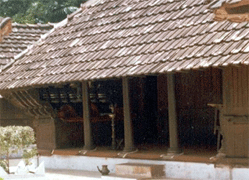 Centuries old Shree Padmanabha Swami temple in the heart of Tiruvananthapuram city majestically proclaims its ancestry. This solid edifice, stands amidst the three star hotels and multi-storied structures, challenging the passage of time. The seven star buildings, with the facade of a glorious past found in Chalai Bazar, Manacaud and Perunthanni, is another attractive sight. They were built contemporaneously with the temple, but the design can be attributed a much older date.
Centuries old Shree Padmanabha Swami temple in the heart of Tiruvananthapuram city majestically proclaims its ancestry. This solid edifice, stands amidst the three star hotels and multi-storied structures, challenging the passage of time. The seven star buildings, with the facade of a glorious past found in Chalai Bazar, Manacaud and Perunthanni, is another attractive sight. They were built contemporaneously with the temple, but the design can be attributed a much older date.
The name seven stars attributed to these buildings, might give a mild shock to many people. This low roofed structure built in timber is unique in many respects. Oriented towards the east, all these buildings follow the same interior designs. The verandah facing the east has a pathayam made of wood, a granary storing paddy seeds, which will be opened only on the tenth of the month of Medam, when the sun is at its zenith. Apart from this, it served as a seat and bed of the head of the family, and is known as udampara. Next to this is thekkepura and the valiyapura. These chambers are meant to be used for only tidy purposes. In the thekkepura a wooden box with four tiny legs is used to keep clothes and valuables. Rice paddy is stored in the valiyapura. Behind these puras is the chityapura, meant for feeding departed souls or ancestors. Behind valiyapura and thekkepura is a cell to keep paddy and later coconuts. This cell called nilavara with an entrance from chityapura was cancelled by covering, when there was no paddy or coconuts to store. Crossing from the landing (Irayam) to the northern side of the house, you enter through the door to an inner quadrangle called thottikkakam which is a quadrilateral verandah around a court yard within the house.
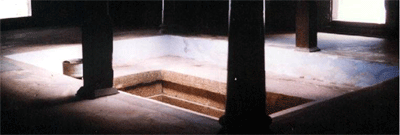 These seven starred mansions are surrounded by outhouses such as a kitchen in the northeast, an uralppura in the northwest, the gosalai in the south east and kalappura in the south west. The uralppura is the place for pounding grain and thekalappura is the threshing floor.
These seven starred mansions are surrounded by outhouses such as a kitchen in the northeast, an uralppura in the northwest, the gosalai in the south east and kalappura in the south west. The uralppura is the place for pounding grain and thekalappura is the threshing floor.
With the increase in the number of stars, mandirs improve their status. Tiruvananthapuram had to content with three star mandirs when other metros had five starred ones. Let us however take solace from the fact that we had always had seven star mandirs and even claim that those who lived in these mandirs were the upper crust of the society. If today's five star buildings need aerodromes and wide high ways by their side, the old seven stars wanted only footpaths by the paddy ranges.
Diwans (chief ministers) of Travancore like Veluthampi (Thalakkulam), Raja Kesavadas (Kunnathoor), Nanoo Pillai (West Neyyoor), Valiya Padathalavan Eravikutti Pillai (Keralapuram) hailed from houses of this pattern and their household estates can be seen in Nanchinadu, known as the granary of the erstwhile Travancore. The House of Ananda Bose, (the founder of the Nirmithi Kendra) at Kottayam, is one such. East facing and rising sun-oriented houses with rooms having identical nomenclature are there in Tiruvanantapuram, Kottarakkara, Nedumangad, Kovalam, Kallada. Names like thottikkakam, chityapura are striking indeed. All these unique attributes made such houses a subject of study.
While the houses in Tiruvanantapuram look like boats sea /lake wrecked, the houses in Palliadi, Muthalakurichi etc., in Kanyakumari district are by the side of the erstwhile paddy fields, which had been taken over by plantations and coconut groves. Even now, in Kollangode one can see elevated poomukham of houses facing such paddy fields. The house of 'Minnal Parama Sivan Nair', a former senior Police Officer of Travancore is one such. The arrival of roads and other allied facilities contributed to population density. After the matrilineal system was abolished when paddy based agriculture holdings fragmented, paddy rice holdings became coconut gardens. This style has become popular, and more households can be expected to face the threat of extinction.
Padippura and Poomugham are built with the increase in the family earnings, and a symbol of show off. The increase in the number of family members necessitated the construction of more additional attachments named vadakkathinu vadakkathu and arappurakku arappura. At this stage, the tarawad becomes more than a fifty member household. We have seen that thethaiveedu is a combination of apura, chityapura nilavara, four faced thottippuram and the four sub-houses in the four corners. A small household can live in this suite comfortably.
There is a thekkathu, a sacred place for worship of family deity, at the south of the main house, usually with no idol. If at all there, it will be of Durga, inclined to southwest. The look of the goddess' idol is at isana konu. In other places Easwara Kala Bhoothathan. In some house, the objects of worship constitutes a pair of wooden sandals or a rod. Thekkathu of houses havingkalari is known as Elankam.
Why such houses are called seven starred? It is an accidental tale.
The Birthday of Rice
From the surface soil where it grows, to the granary (pathayam, a large wooden chest for storing paddy and the grains), the rice is worshipped and formed a necessary ingredient in many a rituals. The talappoli festival held all over Durga temples in Kerala, is an important one. Many virgins and married women, line up in clean white garments, circumambulate the Durga temple with ululas in chorus and offer their worship. They carry rice (paddy), flowers, neerajana in a plate calledthalam. This thalam is the lion seat of Durga, and the poli is rice.
"Maid, born on Makam (asterism), comes out from the granary". To understand the meaning of this well-known rhyme in these places, one should bear in mind the fact that the Makam asterism in the second Malayalam month of Kanni is the birthday of rice. Those who celebrated this festival on the Makam asterism during August-September, every year, carry it as a sweet memory.
On this day, seven grains of rice are collected from the pathway, fallen from the sheaf of harvested rice, carried on head from the fields and taken to the well for a ceremonial bath. Two grains are then thrown away at these two places. Remaining grains washed in water after applying turmeric paste. After adorning these five grains with sacred ashes, sandal paste, kumkum, it is seated with respect, on a pure cloth kept on a sacred platter (talam). After offering flowers on the lighted lamp on thistalam the same is taken to the thekkepura in the accompaniment of ululu in chorus by the household women. The air in the room will then be purified by burning incenses.
On the sacred birthday of rice, no one will till or plough the land, boil paddy or trade in rice. Rice soaked in milk (palchor) is the favorite of the goddess. On full moon day this is an important offering for the Devi temples. A feast cooked at home with jaggery, rice, coconut, turmeric and a pinch of salt was a payasam cooked in the domestic kitchen by the household women in a state of purity. This celebration in southern Travancore has assumed an importance given to Onam elsewhere. The paddy grain enjoyed a complete rest on that day.
It is in the makam asterism that the procession of Saraswathi from Padmanabhapuram palace to Thiruvananthapuram begins. The Navaratri festival starts on makam day with puja of yoke and rice grains and culminates invidyarambham. In other Dravidian localities this ritual is practiced in a slightly different style.
It is difficult to confirm the date of origin of this ritual. It could be a traditional matter only. Yet, let us examine, if there is any basis for the practice of choosing five or seven grains as well as the importance of the makam asterism, the day chosen for the celebration of the birthday.
Of the twenty-seven stars in the Hindu calendar makam asterism is the tenth and is a cluster of five stars in the shape of a yoke (sapti). This asterism is a sickle to the westerners. Makam and Kanni are thus symbols of rice cultivation. If the five rice grains taken for worship represent the yoke, the number seven represent the constellation popularly known as the plough star.
The eastern quarter is maghavathi, Lord Indra is maghavan that is the worshipped one, and Indrani is magahani. Mahamaghavela is a grand yaga. Mahamagham ormamankom or makhamagam was a festival conducted once in twelve years.Makam also has become less of a favourite with people.
Makam was invested with royal aura since it was in the ayanothara position while the utharayana ends and dakshinayana starts. The Mahavishu position has shifted from Medam to Meenam, just as the position has shifted from karkidakom tomithunam.
The saka era (AD 78) starts from the time of the Satavahana (saka) that was 2526 years after Yudhisthira's reign ended. The Saptarshis were in makam asterism, and continued in that position for hundred years. In kaliyuga they are in the chitthirastar. Now we will find more about the makam asterism.
Regulus
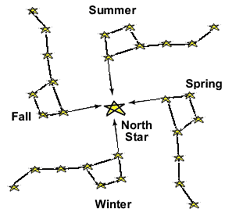 The bitter cold winter nights disappear giving way to warmer spring nights to gaze at the sky. The Big Dipper appears as an impressive and easy to recognize constellation and serves as an aid to locate other constellations. Regulus, one of the brightest spring stars, with a sparkling blue color, lies south of the pointer stars in the Big Dipper and to the northwest of Virgo. The rest of Leo's body, legs, and tail extend to the east. Brightest star in Leo, Regulus is a zodiacal constellation in the northern hemisphere between Cancer and Virgo. Zodiac is a belt-shaped region in the heavens on either side to the ecliptic and Leo is the fifth sign of the zodiac. It is divided into 12 constellations or signs for astrological purposes. The sun is in this sign from about July 23 to August 22.
The bitter cold winter nights disappear giving way to warmer spring nights to gaze at the sky. The Big Dipper appears as an impressive and easy to recognize constellation and serves as an aid to locate other constellations. Regulus, one of the brightest spring stars, with a sparkling blue color, lies south of the pointer stars in the Big Dipper and to the northwest of Virgo. The rest of Leo's body, legs, and tail extend to the east. Brightest star in Leo, Regulus is a zodiacal constellation in the northern hemisphere between Cancer and Virgo. Zodiac is a belt-shaped region in the heavens on either side to the ecliptic and Leo is the fifth sign of the zodiac. It is divided into 12 constellations or signs for astrological purposes. The sun is in this sign from about July 23 to August 22.
Leo the lion that has long been associated with the arrival of spring dominates the spring skies in the northern hemisphere and autumn skies in the southern hemisphere. It is the only constellation that signals the arrival of the mild weather in the northern hemisphere. Leo clears the eastern horizon at the end of evening twilight and by the end of the month it is high in the east as darkness comes. It is said that March comes in like a lion, and goes out like a lamb. True, March comes in with a lion, the constellation Leo, and with it comes the breath of spring.
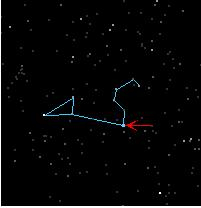 Leo's midnight culmination is around March 1 and the constellation is close to overhead as darkness falls. Leo is a star formation, a crouching lion facing westward. It has a distinctive head and mane formed by a sickle-shaped set of stars with bright Regulus, marking the handle of the sickle. The sickle of stars looks like a reverse question mark and the Regulus serves as the period of the question mark. Behind the sickle, toward the horizon in the east, three stars form a small triangle that marks the rear of the Lion.
Leo's midnight culmination is around March 1 and the constellation is close to overhead as darkness falls. Leo is a star formation, a crouching lion facing westward. It has a distinctive head and mane formed by a sickle-shaped set of stars with bright Regulus, marking the handle of the sickle. The sickle of stars looks like a reverse question mark and the Regulus serves as the period of the question mark. Behind the sickle, toward the horizon in the east, three stars form a small triangle that marks the rear of the Lion.
The Great Dipper, rising upward with its handle downward toward the northeast during March, one can go directly through the bottom of the dipper bowl to find the Lion, go about three times the length of the Dipper handle from the bottom of the bowl. Leo can be located with its brightest star Regulus, in Leo. Regulus is said to be 100 times as luminous as the Sun.
Most visible of the constellations during spring in the northern hemisphere, Regulus is often called the "heart of the lion." Marking the heart of the great lion in the sky, it gave the celestial creature life. Leo has always been associated with the Sun, moving through the zodiac was thought to regulate the seasons. From this, many have supposed that it regulated affairs on earth as well as ruling the heavens. Regulus, the luminary star of Leo, has been called the "regulator" of heaven. No wonder in Latin Regulus means "little king".
Around the time of 2300 BC, Regulus was called the flame star or red fire. This was because of the Sun being near the area of the sky which Regulus occupied. It was thought that Regulus teamed up with the Sun and the combined heat was responsible for the hot weather during this time of the year. Much later, Sirius, the brightest star in our sky, earned the same reputation when precession of the Earth's axis shifted the Sun to be near Sirius during the hot part of summer.
Regulus forms one part of the Spring Triangle. Facing south, and looking about halfway between the horizon and zenith, is a bright bluish star called Spica, in the constellation Virgo, the Virgin.
Magha meaning the mighty one or the great is located near the forehead of the Lion. Its symbol is a palanquin, the royal seat upon which the king was carried through the towns he ruled. Ruled by Ketu, Magha's yoni (source) is Rat. Its motivation is Artha. Its ruling deities are Pitris, the great fathers of humanity. They function as guardian angels giving protection in the event of major calamities on earth. The original progenitors of the human race, as the Pitris are considered; they are still worshipped in traditional Hindu families even today. They help to maintain traditional cultural purity. The Pitris represent ancestral pride and personal power. The words pitru,pritutheertham relate to father. The star makam also is known by this nomenclature- it is the day of the tenth star-suited to perform duties to 'the father.'
Magh (a), the eleventh month of the Hindu calendar, corresponds to January in the Gregorian calendar. Hindu calendar is the lunisolar calendar governing the religious life of the Hindus. An extra month is inserted after every month in which there are two new moons (once every three years). Any lunisolar month in the Hindu calendar is known as the Hindu calendar month. Vaivaswatha Manu's astronomical calendar is based on the Ursa Major Cycle. The constellation of Ursa Major stays in a constellation for 100 years. It is that of the Seven Rishies (Seers), moving along the Zodiac in retrograde motion taken 2700 years to complete one circuit.
Ursa Major, the Great Bear, was in Regulus (Magha) at the start of the Mahabharatha War. In Malayalam the tenth constellation maka is known as nennol (nangol).
Constellation
A constellation is an apparent configuration of stars when seen from Earth, formed in a pattern. They are fortuitously associated in mythological or pictorial grounds. There are eighty-eight recognized constellations. There are also asterisms, smaller apparent star patterns within a constellation, like the Big Dipper, the Little Dipper, and the Pleiades (in Taurus). Asterism is a cluster of stars that constitutes a small constellation and is easily recognized groups of stars.
Either one of the Bears is called Ursa in astronomy. They brightly illuminate the night sky and are known as Ursa Major, Big Dipper, the Great Bear, Charle's wane, Plough, Wagon; and the Ursa Minor, Little Dipper, Little Bear and the like in different countries.
The Akshamala seen in the northern hemisphere like a string of pearls was known as Arundhathi. According to Puranas Vasishta had three births and Arundhathi was his wife in all the three births. In the second birth Arundhathi was known as Akshamala.
The Saptarshi Mandalam
Ursa Major is one of the most conspicuous of the northern constellations, outside the Zodiac that rotates around the North Star. Situated near the pole, it contains 53 visible stars, seven of which form a group of seven bright stars, which form the Big Dipper in the Northern Hemisphere. The constellation Ursa Major and its two brightest stars, Kratu (Dhubhe) and Pulahan (Merak) point to the North (Dhruva) Star, Polaris and are known as pointers. Pointer is a mark to indicate a direction or relation.
Look along the handle of the Dipper for the next to last star. This pair star Mizar with its companion star called Alcor, has long been used as a test for eyesight. Seeing Alcor with the unaided eye is considered as having good eyesight.
The Big Dipper high overhead in the northern sky is upside down, pouring its celestial contents in the night sky. Seven stars in the constellation Ursa Major is also known as Septentrion (Sep-ten-tri-o). Here septem is seven and the triones plural of trio is, a plow or ox according to Funk and Wagnalls, International Dictionary. In India this group of seven very bright stars is known as Saptarshi. In Tamil it is known as ezhumeen. They are visible when the sky is not overcast. The plough as it is known in England rises from the North Pole and sets in the northwest. For the Americans they are the big dipper.
It is necessary to study these concepts in the puranas to learn about the perception prevalent in those days.
Nancil/ nangol means a plough. Nanchinadu means the land of the plough. The Indians who called it a plough saw Marichi at the handles' end and the sixth star is Vasishta besides Arundhathi. On the northeast side are Pulasthya and Pulahan. This line ends in Dhruva that is the plough's sharp end points to the Dhruva star.
Nangol, a Dravidian word, implies a group of stars in the shape of the plough. It rises in the Dhanu rasi, one hour after sun set. As a part of the beginning for the preparation for sowing paddy seeds, it marks time to empty the paddy field by pumping out water with the help of water wheel, known as chakrapathayam.
A dipper is a long handled bowl shaped utensil used principally for dipping liquid. It is also referred as a ladle, a spoon-shaped vessel with a long handle; used to transfer liquids. Dipper is known fortekkotta, a vessel used for bailing out water.
The stone vessel or bucket to collect water is known in Malayalam as thotti. The suite meant for the women in the taiveedu is called as thottikkakam. During rainy seasons, from the roof of the four talams, slanting towards the thotti, rain pours down heavily. The water, collected in the bucket like structure, empties automatically, trickling down to earth reinforcing the well and the tank in the vicinity of the house. This part of the house resembles the dipper in the Big Dipper formation.
Dhruva Mandalam
A star that is located almost due north or due south and is useful for navigation is known as pole star. Polaris is the pole star of the Northern Hemisphere and is the brightest star in Ursa Minor.
Also called the Lodestar or the Cynosure, Polaris is the guiding star, a star that is used as a reference point in navigation. Tara means that which helps a boatman. Tharaka indicates the course of the night Dhruvatara is believed to be an old name of taraka. For our ancestors, tarakawas a guiding light. Tara also means footprints. We may even know more about our ancestors foot prints by looking afresh at Dhruvathara.
The shape of the Dipper is so distinctive that it cannot be overlooked and is extremely useful as a guide for locating other stars and constellations. Ursa Minor is usually found and it resembles a faint and distorted version of the Ursa Major.
As the earth rotates the celestial pole remains stationary while all other objects appear to circle it slowly. At its brightest, Polairs is about 6,000 to 10,000 times brighter than the Sun. Only in the north, pole star could be seen directly overhead. It is the larger star at the end of the handle of the Little Dipper (Ursa Minor).
Riksha is that which covers up darkness. It also means bear in the sense, one that kills. The end of an aksha is known as Dhruva. The Polaris/pole star is one such. This is one and a half degrees in a slanting position.
Mahabalu and Balu are identical. In size Balu is one third of Mahabalu. Ursa minor starts from Polaris. Dhruva is known as Pole, because of its immobile nature. But even that moves on close observation. Dhruva can be seen moving from the north to west while the earth moves east circling the sun, Dhruva moves to the west.
Dhruva shining bright has been guide to travelers and so mentioned in puranas. The line Dhruva- dhruvam- Marichi starting from the Marichi star, the edge of the handle of the plough points to the north towards Dhruva. These two stars of the plough are also known as Dhruvadarshi. It is easy to draw the plough Dhruva line.
The pole, which is used to tie the cow, is known as the methi. Methi is also known for the yard for storing paddy grains. The word Dhruva is used to in the sense of a permanent, firm one inBhagavatha Puranam, preparing the paddy by using bulls is compared to the Dhruva star. On the north western corner of the house a small building is constructed for preparing rice from paddy, known as kalappura. Kalappura takes the place of Ursa Minor of the Balu group of stars.
Saptarshis in Indian Thoughts
According to Vishnupurana, Rudra originated from the forehead of Lord Brahma. At the same time Dharma concept, the basis of all creations also originated. If the samkalpa came from Brahma's will power, dharma came from his satwa. From his breath came Daksha. From both of his eyes came Marichi, Bhrigu. Angiras came from his forehead, Atri from the ear, Pulasthya from the udanan, Pulaha from vyanam, Vasishta from saman, Krathu from apana. All the twelve are born of Brahma.
The seven organic holes in the head of man that is the ear, nose, eyes and mouth were considered saptarshis in the Vedas. Brahma created them from his breath. One can attain salvation by realizing the seven pranas. These pranas are doors leading to immortality. On death, when the body perishes, the breath joins the Brahman.
Like a bull tied to the yoke is pranas tied to the human body. The Mundakopanishad comparesprana to the nucleus of a wheel. According to the Sathapatha Brahmana, the saptharshi are seated in the eyes, ears, mind and breath.
Application in House construction
Our ancestors who viewed the North Pole as the seven stars and plough as the seven organs of the human body, and also as saptaprana, they did not write about the application of the saptarshi concept in their own dwelling houses. However the taiveedu that survived centuries remains as an outline of what they had about saptarshis in their mind.
Varahamihira, the author of Brihatsamhita (AD 550) and one of the nine gems of the court of Vikramaditya mentions saptarshis. They are in the following order, from east to west- Marichi (Alkaid), Vasishta (Mizar), Angiras (Alioth), Atri (Megrez), Pulastya (Phecda), Pulaha (Merak), Krathu (DuBhe), Arundhati (Alcor), Dhruva (Polaris). We have seen that taiveedu is an arrangement of thekkepura, valiyapura, chityapura, cellar and four verandas around a courtyard within a house. If these puras can be named as Marici, Vasishta, Angiras, Arundhati, Athri, Pulasthya, Pulaha, Krathu respectively, the emerging picture is that the taiveedu embody the plough or saptarshis. Let us remember that the word Salini means paddy and also Arundhati. After all the nilavara is the original place for storing rice paddy, and it represents Arundhati. Thetekkathu is an embodiment of Makam (nennol). As for as the kalappura of taiveedu, tekkathu, andkalappura are a replica of the north polar constellations of Ursa Major, Regulus and Ursa Minor respectively.
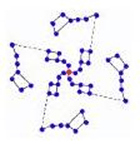 In the Saptarshi mandiram thekkepura (Marici) and kalappura the threshing yard (Dhruva) when connected by a straight line takes the shape of a single spoke of swasthika. In traditional constructions swastikas full shape is incorporated in the construction of the nalukettu.
In the Saptarshi mandiram thekkepura (Marici) and kalappura the threshing yard (Dhruva) when connected by a straight line takes the shape of a single spoke of swasthika. In traditional constructions swastikas full shape is incorporated in the construction of the nalukettu.
The architectural style incorporating a full swastika form is an ancient concept. In the early days of agriculture when technology was not fully developed, such conceptions were enough. The seven star mansions were adequate to understand seasons and organize agricultural activities and the style based on agriculture was suitable for those periods.
The ancients considered man as a miniature universe. They linked the pattern of the human body with the scheme of the universe. The sushumna is one of the seven nerve centers. When a yogidies, the breath goes out rupturing the center. The top of the head is considered the North Pole. The heavenly journey is a rise from the kundalini to the sahasram. The sushumna is invisible connected with the aksharekha, which is invisible to the naked eye.
The essence of the universe that has been comprehended in this pattern of house construction has also evolved in it a social order appropriate to that understanding. Grihasthasrama is the second of four ashramas (stages) in one's life. Here the householder, along with his family forms the basic unit of the Indian social order. This social organization is peculiar to India similar to the larger Indian views of the universe.
22-Jan-2004
More by : Dr. V. Sankaran Nair